Micro Moves Of Tigers Release
November 2009
- by Kelvin Miyahira
The Tiger impact position is part of a total release move that consists of several key micro moves (Phil has these same moves since they both learned something from Butch). Earlier articles pointed out left wrist supination and flexion (bowing), but I left out an extremely important micro move; ulnar deviation (UD).
Simple Definition of Ulnar Deviation

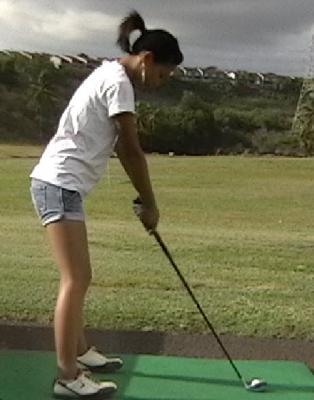
The simple, anatomical explanation of ulnar deviation is that your wrists and fingers bend down toward your pinky while your thumb points down. So take your address position and leave the club on the ground while you lift your hands vertically up. That’s ulnar deviation.
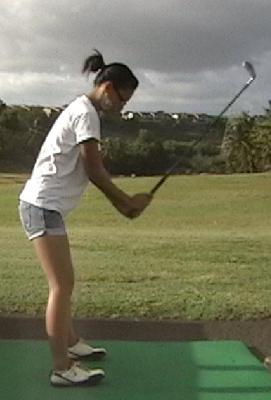
If you do the opposite move and lift the club up to your head by bending your wrists, that’s called radial deviation.
UD: Important part of the release
What makes UD important is that this is occurring in both hands while the left hand/wrist is supinating (rotating) and undergoing flexion (bowing). Ultimately, UD might be the controlling unit that either allows or disallows the first two movements.
To help unravel this mystery, I’ve got online student Rich Amoroso, violinist in the first violin section of the Philadelphia Orchestra and 3 handicap golfer as my model.
He’s reluctantly demonstrates his old flipper swing so that we can analyze the movements that are occurring in a mediocre swing.
Golfer’s Conundrum
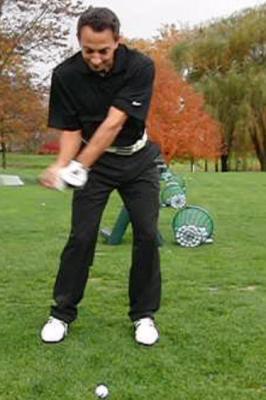

Sorry that Phil’s bag was in the way but as you’ll see later, this is a great video. I’ve switched him to right handed for easier comparison purposes as you can see.
So here’s Rich looking similar to Phil but here’s the challenge that faces all of us. The few that have solved this mystery can play great golf. The majority of us that haven’t solved this mystery correctly are doomed to a golf life of inconsistency and downright misery.
The question the golfing gods have given is, “how does one get the club down to the ball?” The club is at about hip high and off the ground by about two feet or so.
The Flipper’s answer is to use right hand flexion or what we call the flipping action in order to get the club on the ball.
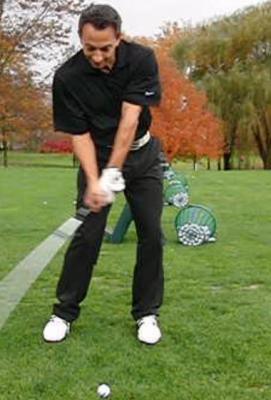
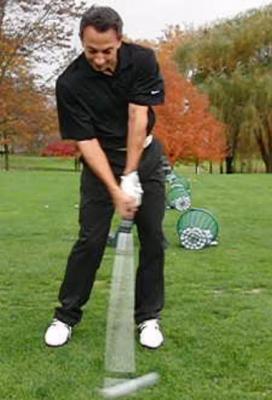
As you can see, Rich has a cupped left wrist and right hand slightly flexed forward at impact. He does get the club on the ball and hits it well enough to play very good golf by his amateur buddies’ standards. But against tour pro standards, it falls well short. Why?
Unintended Consequences of Flipping
There are several damaging consequences of the flip and everyone who does this already knows this. One is that the clubhead reaches the bottom of the swing before impact. This causes fat shots from time to time. And if you fear fat shots, sooner or later you hit it too thin or skull one over the green because you pull up too soon. Thus contact errors are part of the package when you use the flip method.
Two, the flip adds loft to your club and therefore shots. So you tend to hit your seven iron like everyone else’s eight iron. And that’s if you only have a minor flip like Rich. Massive flippers can lose 20-30 yards per club so if you’re lacking distance, pay special attention.
And three, flipping causes an overly fast rotation of the clubface angle through impact. This means far left if released too early and far right if released to late. It’s a tricky, timing-sensitive way to hit the ball. Luckily, most of you don’t have the 120+ mph clubhead speed that would make matters even worse.
UD Answer
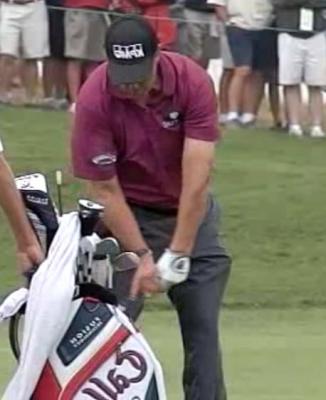
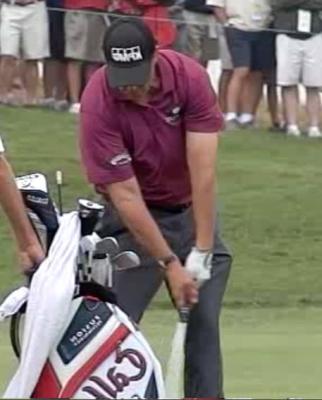
Here’s Phil beginning to use UD to get the club down to the ball WHILE bowing his left wrist, rotating his left forearm and retaining an angle in his right wrist. Due to hand position relative to camera angle it is difficult to see UD from this angle but it is happening as we will see later.
Flipper vs. UD Post-impact
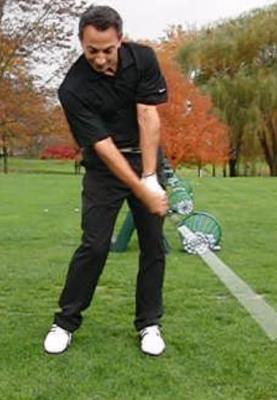
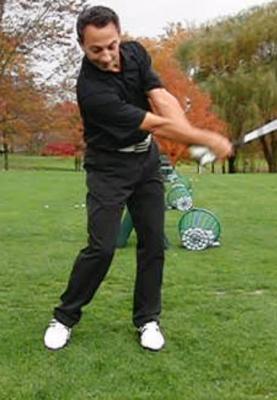
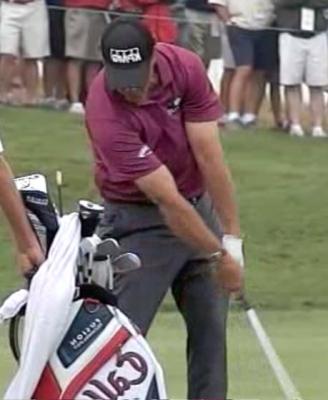
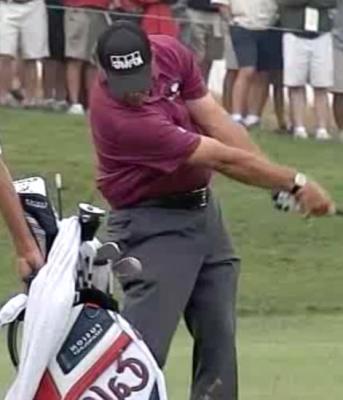
Big differences in the two swings. Rich has his right hand flipped under and by hip high he’s re-hinging.
Contrast that to Phil. Notice Phil’s raised left wrist bone just after impact and a little later he’s got his right wrist showing the max UD curved downward.

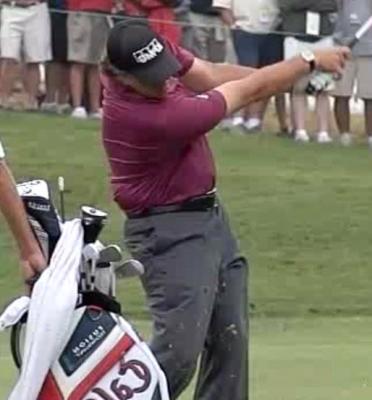
Even nearing the end of his follow through, Phil has retained the UD in his firm wrists. The shaft is very close to being in alignment with his right arm at this point. Quite different isn’t it?
Stewart Cink’s UD






Look at 2009 British Open champion Stewart Cink using UD during his release move. Based on biomechanical data, we know that the average tour pro begins to move towards UD from just before impact till just after impact. If you look at Cink’s follow through, you see that he retains this UD position well into the follow through before “re-hinging” just as Phil does. Perhaps Butch might be one of the few teachers that actually knows something about this too.
Bonus Gifts from UD!!
From clinical biomechanical studies, they have found that if the wrist is in a neutral position it has its full range of motion. Does this sound good for an impact position or would you rather have a limited range of motion? Sounds like if you have a full range of motion it will lead to more impact errors and inconsistency.
Thus, the bowed, supinated and UD wrist is in a far more limited in its range of motion therefore it is in a more repeatable position than the neutral position.
Also, you’d find it’s your anatomically the strongest position. Just think of playing in a tug of war. What position would your left wrist be in? Wouldn’t you find your strongest position to be in?
UD seen from target line view
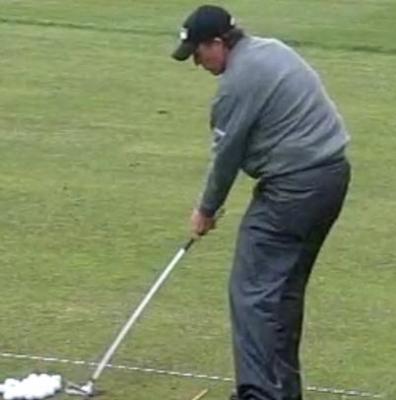
From this angle, we can see how Phil’s back hand is slightly angled upward or RD at this point.

Post impact, his rear arm has straightened and so has his wrist. So UD is helpful in straightening the arm.

At this point he’s in max UD position and will try to hold it as long as he can. There is a slight downward curve in his right wrist.
Address position is NOT impact position
Many teachers believe that your shaft plane should return to impact at the same position it was at address. If that is so, your wrists would not be able to perform UD because it would need to stay in a slightly radial deviated position.
Planeologists are careful to return to this magical position as well. But what are the reasons behind it? Because someone said so? Be careful of the Kool-Aid.
One popular notion is that the swing is a circle and that’s why the club should swing back through its starting point. While there may be some truth to that but that is being a bit too simplistic to understand the complexity of a golf swing.
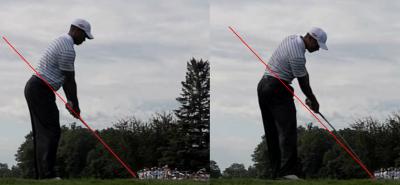
As you can see clearly, Tiger has his hands higher at impact than they were at address. See the UD in his right hand angling down?
Follow-up with Rich
After months of trying, Rich is starting to get it. Here is his latest sequence.
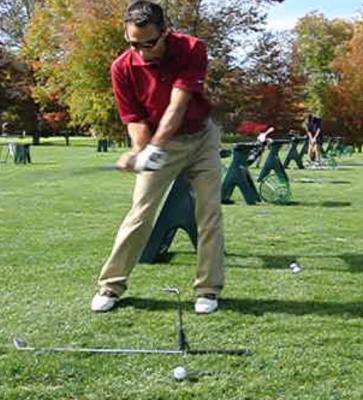

Here’s a far more solid impact position.
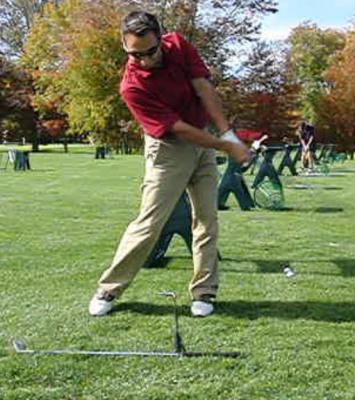
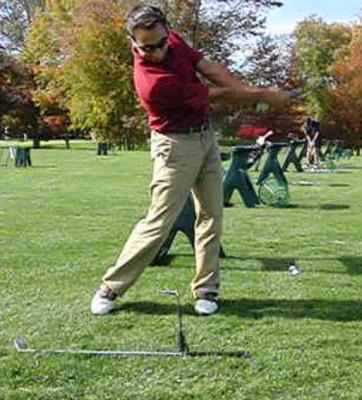
Slight UD position. Could be better of course. But it’s way better than his flip swing. Even his body is moving better.
Learning UD with rubber tubing
There are two ways to develop a feel for UD. One is to use rubber tubing or a bungee. Start by hooking the rubber over your right thumb and holding the other end with your left hand on your right chest. Doing this correctly will stretch the rubber in an increasing manner as you UD and straighten your arm. If you flip, the rubber band will flop.
Learning UD with CLT

The other way is for those that have a chi line trainer to do punch drills. The handle’s unique shape allows you to work harder to execute UD by having to “raise” the bottom of the triangle up which increases the chi line trainer’s chain resistance at the right time to incorporate this move.
UD in low spinning pitch shot
Many people desire to hit the low spinning wedge shot that Hogan talked about. It’s very simple if you know how to use the trio of micro moves UD, supination and left wrist bow. But if you don’t, it’s not likely you’re going to learn it from overly simplistic magazine articles talking about hitting down and getting clean contact. Those are naturally going to occur if you have all the right moves.
Even Phil Mickelson’s short game DVD glosses over important technical elements that create the “hinge and hold.” It’s a great DVD if you already know how to swing the club properly but if you don’t, it’s kind of hard to learn just by thinking hinge and hold.
So let’s take this opportunity to learn how to hit better short shots so that eventually you can transfer these same movements to high speed full swings. Here’s a former collegiate player from Japan Misako Nakamura showing her excellent pitching technique.
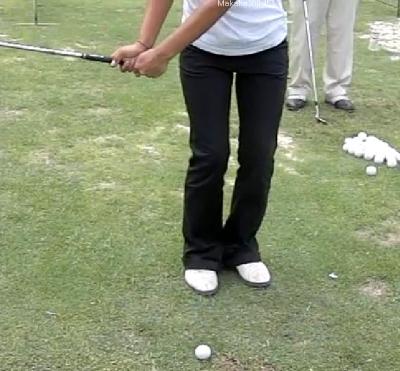
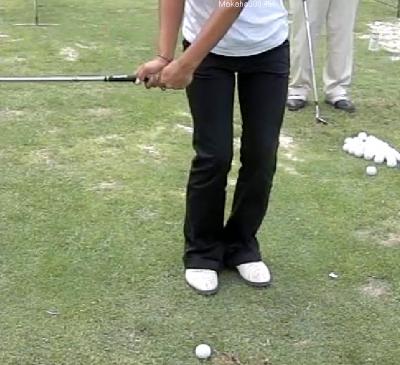
The ball position should be off the right foot. Take a short backswing and keep the weight relatively centered on the backswing.

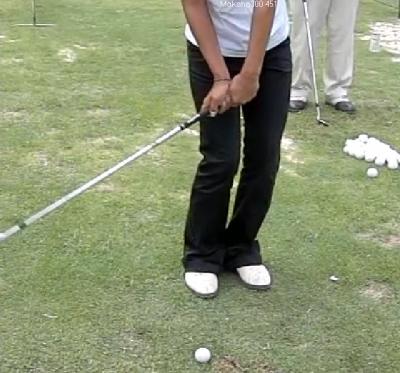
Start the bowing of the wrist.
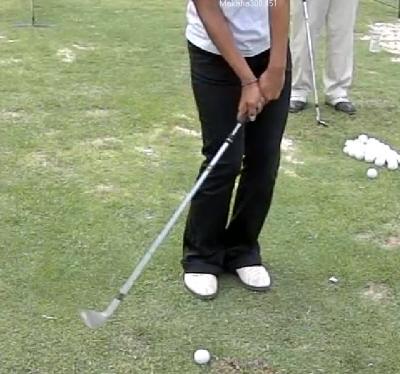

Rotate the left forearm and UD quickly into impact.
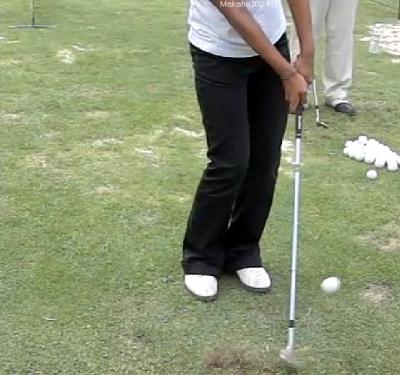

Continue to UD max at this point and hold.
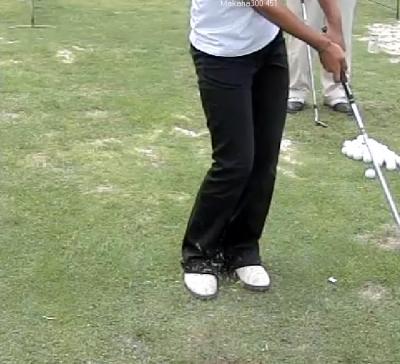
The finish should be very strict. Don’t allow wrist break, arm bend or long follow through initially. If you can’t stop the swing, it is probably because you’re flipping it.
Once you’ve mastered the three moves and can hit with a firm follow through, you will be able to hit very good low pitch shots.
To add more backspin to those low pitch shots you can relax your left wrist and right hand through impact to create the extra spin. This will allow you to lead all the way through impact with the bowed left wrist and then cup the left wrist slightly to allow the face to stay more open through impact thereby increasing spin.
This should produce the low spinning wedge shots and train you to use this same trio of moves that will make you a better ballstriker for your full swings.
Simple Definition of Ulnar Deviation


The simple, anatomical explanation of ulnar deviation is that your wrists and fingers bend down toward your pinky while your thumb points down. So take your address position and leave the club on the ground while you lift your hands vertically up. That’s ulnar deviation.

If you do the opposite move and lift the club up to your head by bending your wrists, that’s called radial deviation.
UD: Important part of the release
What makes UD important is that this is occurring in both hands while the left hand/wrist is supinating (rotating) and undergoing flexion (bowing). Ultimately, UD might be the controlling unit that either allows or disallows the first two movements.
To help unravel this mystery, I’ve got online student Rich Amoroso, violinist in the first violin section of the Philadelphia Orchestra and 3 handicap golfer as my model.
He’s reluctantly demonstrates his old flipper swing so that we can analyze the movements that are occurring in a mediocre swing.
Golfer’s Conundrum


Sorry that Phil’s bag was in the way but as you’ll see later, this is a great video. I’ve switched him to right handed for easier comparison purposes as you can see.
So here’s Rich looking similar to Phil but here’s the challenge that faces all of us. The few that have solved this mystery can play great golf. The majority of us that haven’t solved this mystery correctly are doomed to a golf life of inconsistency and downright misery.
The question the golfing gods have given is, “how does one get the club down to the ball?” The club is at about hip high and off the ground by about two feet or so.
The Flipper’s answer is to use right hand flexion or what we call the flipping action in order to get the club on the ball.


As you can see, Rich has a cupped left wrist and right hand slightly flexed forward at impact. He does get the club on the ball and hits it well enough to play very good golf by his amateur buddies’ standards. But against tour pro standards, it falls well short. Why?
Unintended Consequences of Flipping
There are several damaging consequences of the flip and everyone who does this already knows this. One is that the clubhead reaches the bottom of the swing before impact. This causes fat shots from time to time. And if you fear fat shots, sooner or later you hit it too thin or skull one over the green because you pull up too soon. Thus contact errors are part of the package when you use the flip method.
Two, the flip adds loft to your club and therefore shots. So you tend to hit your seven iron like everyone else’s eight iron. And that’s if you only have a minor flip like Rich. Massive flippers can lose 20-30 yards per club so if you’re lacking distance, pay special attention.
And three, flipping causes an overly fast rotation of the clubface angle through impact. This means far left if released too early and far right if released to late. It’s a tricky, timing-sensitive way to hit the ball. Luckily, most of you don’t have the 120+ mph clubhead speed that would make matters even worse.
UD Answer


Here’s Phil beginning to use UD to get the club down to the ball WHILE bowing his left wrist, rotating his left forearm and retaining an angle in his right wrist. Due to hand position relative to camera angle it is difficult to see UD from this angle but it is happening as we will see later.
Flipper vs. UD Post-impact




Big differences in the two swings. Rich has his right hand flipped under and by hip high he’s re-hinging.
Contrast that to Phil. Notice Phil’s raised left wrist bone just after impact and a little later he’s got his right wrist showing the max UD curved downward.


Even nearing the end of his follow through, Phil has retained the UD in his firm wrists. The shaft is very close to being in alignment with his right arm at this point. Quite different isn’t it?
Stewart Cink’s UD






Look at 2009 British Open champion Stewart Cink using UD during his release move. Based on biomechanical data, we know that the average tour pro begins to move towards UD from just before impact till just after impact. If you look at Cink’s follow through, you see that he retains this UD position well into the follow through before “re-hinging” just as Phil does. Perhaps Butch might be one of the few teachers that actually knows something about this too.
Bonus Gifts from UD!!
From clinical biomechanical studies, they have found that if the wrist is in a neutral position it has its full range of motion. Does this sound good for an impact position or would you rather have a limited range of motion? Sounds like if you have a full range of motion it will lead to more impact errors and inconsistency.
Thus, the bowed, supinated and UD wrist is in a far more limited in its range of motion therefore it is in a more repeatable position than the neutral position.
Also, you’d find it’s your anatomically the strongest position. Just think of playing in a tug of war. What position would your left wrist be in? Wouldn’t you find your strongest position to be in?
UD seen from target line view

From this angle, we can see how Phil’s back hand is slightly angled upward or RD at this point.

Post impact, his rear arm has straightened and so has his wrist. So UD is helpful in straightening the arm.

At this point he’s in max UD position and will try to hold it as long as he can. There is a slight downward curve in his right wrist.
Address position is NOT impact position
Many teachers believe that your shaft plane should return to impact at the same position it was at address. If that is so, your wrists would not be able to perform UD because it would need to stay in a slightly radial deviated position.
Planeologists are careful to return to this magical position as well. But what are the reasons behind it? Because someone said so? Be careful of the Kool-Aid.
One popular notion is that the swing is a circle and that’s why the club should swing back through its starting point. While there may be some truth to that but that is being a bit too simplistic to understand the complexity of a golf swing.

As you can see clearly, Tiger has his hands higher at impact than they were at address. See the UD in his right hand angling down?
Follow-up with Rich
After months of trying, Rich is starting to get it. Here is his latest sequence.


Here’s a far more solid impact position.


Slight UD position. Could be better of course. But it’s way better than his flip swing. Even his body is moving better.
Learning UD with rubber tubing
There are two ways to develop a feel for UD. One is to use rubber tubing or a bungee. Start by hooking the rubber over your right thumb and holding the other end with your left hand on your right chest. Doing this correctly will stretch the rubber in an increasing manner as you UD and straighten your arm. If you flip, the rubber band will flop.
Learning UD with CLT

UD in low spinning pitch shot
Many people desire to hit the low spinning wedge shot that Hogan talked about. It’s very simple if you know how to use the trio of micro moves UD, supination and left wrist bow. But if you don’t, it’s not likely you’re going to learn it from overly simplistic magazine articles talking about hitting down and getting clean contact. Those are naturally going to occur if you have all the right moves.
Even Phil Mickelson’s short game DVD glosses over important technical elements that create the “hinge and hold.” It’s a great DVD if you already know how to swing the club properly but if you don’t, it’s kind of hard to learn just by thinking hinge and hold.
So let’s take this opportunity to learn how to hit better short shots so that eventually you can transfer these same movements to high speed full swings. Here’s a former collegiate player from Japan Misako Nakamura showing her excellent pitching technique.


The ball position should be off the right foot. Take a short backswing and keep the weight relatively centered on the backswing.


Start the bowing of the wrist.


Rotate the left forearm and UD quickly into impact.


Continue to UD max at this point and hold.

The finish should be very strict. Don’t allow wrist break, arm bend or long follow through initially. If you can’t stop the swing, it is probably because you’re flipping it.
Once you’ve mastered the three moves and can hit with a firm follow through, you will be able to hit very good low pitch shots.
To add more backspin to those low pitch shots you can relax your left wrist and right hand through impact to create the extra spin. This will allow you to lead all the way through impact with the bowed left wrist and then cup the left wrist slightly to allow the face to stay more open through impact thereby increasing spin.
This should produce the low spinning wedge shots and train you to use this same trio of moves that will make you a better ballstriker for your full swings.

